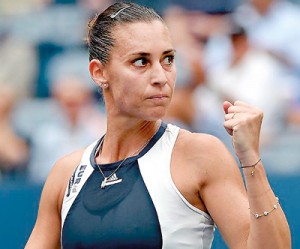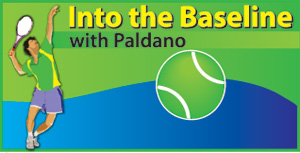Tennis – Compass and Diamond road
View(s):For the Women’s Tennis Association (WTA) and the Association of Tennis Professionals (ATP) – the two professional world bodies, events in the next two months are only to round off the season and to make the year-end masters final event in Singapore and London impressive. That involves only the top eight of the world rankings in each gender.
All others ranging from players in the world rankings to the local and neighbourhood players, will have to do 2015 stock-taking and come up with a true ‘balance-sheet’. Celebrations and short-comings will be in equal portions. This is inevitable, after all who gets everything right in life. The secret of being successful lies in the task of taking and remaining in the Diamond-Road till the goals are achieved. It is the culture that succeeds.
Along with the balance-sheet, seeking direction for the next season will place a ‘Tennis-Compass’ in every player’s hand. There is no escape from this, whoever the entity is. From the controlling bodies through to the eight-year-olds who want to pick up a racquet in January 2016 will have to lay down the ‘terms-of-involvement’ for the coming season.
A ‘compass’ is meant to show direction. The Tennis ‘compass’, if there is one, must be a complicated instrument to use. It not only has to give direction but also point the way towards success. On a rough estimate chances of becoming a top ten player in the world is ever so small, that is, a five million to one probability and that is not over-stated. In Sri Lanka, we have not had a player in the top 250 of the world ranking in nearly 30 years and none in the top 100 ever.

Flavia Pennetta
Who were we?
The first step to use the Tennis ‘compass’ well will be to know who we are and where are we coming from. So cautiously let me recollect our Island’s Tennis firsts, which I know reasonably well.
Often we claim that the yesteryears were the best for sport, hence, the past first. Nobody is born a sportsman but became one. Some being ‘talented’, whatever that may be, went further in their sports careers than others and hard- work went even further. In our age everybody goes to school. This is where we began to be interested in sport because schools have ‘what it takes’ to make a sports-person.Reaction is the language of sport. Schools in the process of tutoring students for sports induce the ability to react. A fact now not in trend and it is our fatal issue in our education. All-round sportsmen got better with their reaction. For this reason schools were well organized to expose students to as many sports as possible. So it is right to say multiple sport exposure, induces better reaction in players than a mono sport approach.
The Clubs and Associations
What the schools built in students was enhanced in our club system mostly as specialised sport. It is easy to notice this in cricket today and it was so in many sports some time ago. Clubs are the affiliates and the building blocks of Sports Associations in our country. It is the club in effect by design became the implementing end of secondary-sports development in the island. We did not have anything beyond that. What came after that was individual effort and pursuit. The creation of the Sports Ministry in the sixties was to give territory development. Except in Cricket we failed here.
Clubs in the past was the best place to develop competition maturity in Tennis players. Once a player reached top ten in a club then it was the ‘Indian Tennis Circuit’ that was available as the next step.
Professional path
To my surprise I found out in the top 500 of the world more than half are not full time professionals. Today not many stop their education for Tennis. So the question looms as to how they manage it. Our neighboring India which is fast developing to be a successful ‘doubles’ country, their Association have events which leads players into the top 500 ranked singles players.
This in turn exposes their players to a high plane in competition while being colleagues. At the top end of development the strength of the competition a player faces will decide the maturity of the player and not the coach or coaching.
A well known European promoter of the 80’s stated recently that a potential player in Europe cannot be identified till she or he is 17 years of age. In our part it would be a little later because of our genetic make-up. Then it takes three to four years in Tennis to mature as a high end performer. Of the up to five million who take to Tennis every year, eighteen years later out of that, only a number less than ten will survive into the top five hundred of the world. This is so in many sports. Winning in sports have to be unconditional. This happens only when players are mature. As the last Grand-slam winner of Tennis in 1969 Rod Laver states: ‘The ability to win on a bad day that makes a champion who could win the Grand-Slam’. A good sportsman is rarer than a diamond!
Diamond Road
In the light of all these to become a good Tennis player, the use of the Tennis ‘compass’, if there is one, to show the diamond road will be a search that will lead the player to the school sports system as the starting point. Engaging and excelling in a school sports system and exposure to Tennis has been the best for us for early development and to pick up the basics of ‘reaction’. The sure road to succeed in Tennis is from the very early age onwards to keep developing ‘good-reaction’ and address all the physical needs to achieve this.
Pennetta’s story
Italy’s Flavia Pennetta was not the name the Tennis world picked to win this year’s US-Open women’s title. She was given a slim chance of 150 to 1. The direction she got to be successful only at the age of thirty three shows how tough it is to reach the top.
 Although Flavia did not have much opposition in the finals playing her good friend Roberta Vinci, her semi-final match against Romania’s Simona Halep and the quarter-final match against Czech Republic’s Petra Kvitova were very tough. She picked up the ‘Diamond’ in the last match of her career at an age that is late for a player. Her total career prize money only reached closer to 14 million dollars. Flavia Pennetta’s Tennis ‘compass’ showed the long and winding road and she had the motivation, courage, energy and determination to stay on it till the end. Her name appears in the list of players qualifying for the WTA Singapore masters in November this year.
Although Flavia did not have much opposition in the finals playing her good friend Roberta Vinci, her semi-final match against Romania’s Simona Halep and the quarter-final match against Czech Republic’s Petra Kvitova were very tough. She picked up the ‘Diamond’ in the last match of her career at an age that is late for a player. Her total career prize money only reached closer to 14 million dollars. Flavia Pennetta’s Tennis ‘compass’ showed the long and winding road and she had the motivation, courage, energy and determination to stay on it till the end. Her name appears in the list of players qualifying for the WTA Singapore masters in November this year.
George Paldano, former international player; Accredited Coach of Germany, National coach, Davis Cup and Federation Cup Coach; ITF and USPTR; –contact-gptennis.ceylon@gmail.com


